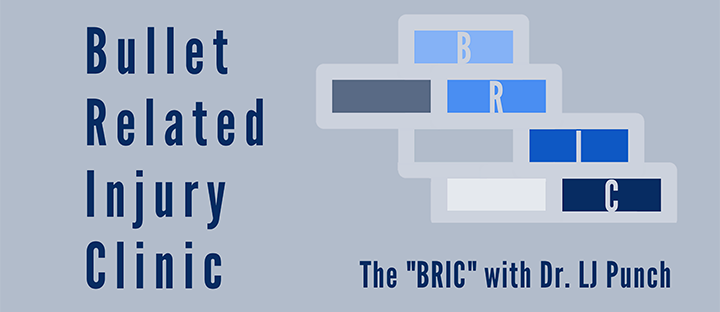In the St. Louis region, hundreds of people with bullet-related injuries are treated on an outpatient basis and directly released from the emergency department (ED) each year.
Without a determined need for additional inpatient follow-up, people are left to manage their wounds and pain alone. Trauma surgeon, Dr. LJ Punch, conceived of a new community-based clinic to reach this population and help them heal.
In November 2020, Dr. Punch launched the Bullet Related Injury Clinic (BRIC), a free clinic designed to support participants managing their own self-care after a gunshot wound. The BRIC, which operates out of the T, offers guidance on both physical and mental healing, including topics of wound-care, nutrition, sleep, stress, trauma, and pain management.
BJC’s Barnes-Jewish Hospital and SSM’s DePaul Hospital serve as pilot sites for the clinic and send referrals directly to the BRIC. The clinic also accepts community and self-referrals. The St. Louis Regional Health Commission has collaborated closely with Dr. Punch to help launch the BRIC, and the program received pilot funding from SSM Health, BJC HealthCare, and Saint Louis Mental Health Board (MHB).
The clinic is off to a great start. In the first six months of operation, the BRIC surpassed its participant enrollment goal. 82% of eligible referrals who are successfully reached by phone enroll in the program. The total number of enrolled participants, 59, exceeded the BRIC’s initial six-month goal of 50, determined by national and regional benchmark data. Phone access and transportation were the most common barriers to contact, while access to wound care supplies and effective pain control were leading factors in successful contact.
In addition to having a high enrollment rate, the BRIC also accomplished a high participant retention rate. In fact, 80% of first-visit participants went on to complete additional visits, with some participants completing as many as six. The BRIC also referred over 40% of participants to a partner program, strengthening the region’s violence prevention infrastructure by serving as another meaningful referral source.
Finally, the BRIC has demonstrated promise in decreasing hospital recidivism. Additional data review is needed, but preliminary findings show that less than 20% of participants reported subsequent unplanned ED encounters, which is less than the regional average. The BRIC has plans to collaborate with hospital partners to develop a regional bullet wound discharge protocol to further optimize clinical outcomes and reduce hospital return rates. This protocol will prioritize evidence-based, person-centered, and trauma-informed care.
Partners discuss the unique role the BRIC has served in the community. “The BRIC is absolutely essential to the St. Louis Region,” describes Kateri Chapman-Kramer, MSW, LCSW, Project Coordinator of Life Outside of Violence (LOV). “Particularly for underserved (uninsured, underinsured) victims of violence, the BRIC represents just and human care for many individuals that often do not receive needed physical and mental follow-up after violent injury. It is unique in that there is welcome space to answer questions in a community-setting that many individuals and their families are afraid to ask, or simply do not ask, in a typical medical setting. The holistic model of the BRIC treats the entire person – and further the entire community. This type of approach is what is needed to continue to heal community violence in our region. I cannot speak enough to how thankful LOV is to be a partner with the BRIC!”
The BRIC fits into a wider network of violence prevention work, spearheaded by the St. Louis Area Violence Prevention Commission (VPC). Jessica Meyers, Coordinator of the VPC explained, “The BRIC fills a gap in services for those who leave the hospital after a gun violence injury but have not yet been connected to service. This is especially important for the uninsured and underinsured in our community who may not have access to the follow-up care and supplies they need to recover. The BRIC’s focus on holistic healing reminds all of us that trauma affects the mind and body and we must help victims of violence to recover physically and mentally in order to heal after trauma. The BRIC complements the work of the Violence Prevention Commission to create wraparound services for victims of violence including partnering as a resource for our 211 Gun Violence Intake.”
The BRIC is an extremely valuable resource to those suffering from bullet-related injuries, and St. Louis is fortunate to be able to direct survivors to such a support system, helping them to take care of themselves and heal.
To learn more about the BRIC, visit www.thebric.org. Click here to make a referral for a client, friend, or for yourself.
For more information on VPC, visit www.stlareavpc.org and check out their social media @stlareavpc on Facebook and Twitter. To support agencies who want to plan additional youth events, VPC also created stlareavpc.org/safer-summer. On that site, you can find a Pop-Up Event Toolkit that helps agencies plan safe space events for youth.

